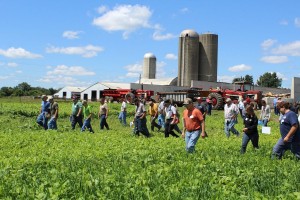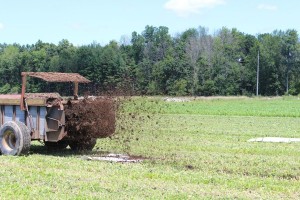STERLING, Ohio — No two livestock farms are quite the same, and the way they manage their manure and other wastes usually differs, as well.
However, all face similar challenges and opportunities in how they transport manure, how and when to apply it, and the fact that with animal agriculture — handling manure is simply a fact of doing business.
On Aug. 14, a large crowd of farmers and industry representatives gathered at the Rupp Vue dairy farm in northern Wayne County, for the annual Manure Science Review.
Sponsored by Ohio State University Extension and local ag industry partners, the event highlighted the “science” of everything that has to do with today’s manure storage and application.
 Mike Rupp, third-generation farmer, welcomed the crowd to his family’s farm, which includes 300 milking cows and about 1,100 acres of crops.
Mike Rupp, third-generation farmer, welcomed the crowd to his family’s farm, which includes 300 milking cows and about 1,100 acres of crops.
The farm has slowly grown over the years and as Mike put it, more cows equals more milk, and more manure to haul. The farm has enough manure storage for about three months, which means the lagoons have to be emptied regularly, and hauling manure is a regular part of farm work.
Widening the window
The Rupps have worked to widen their application window by growing cover crops, which help keep the nutrients in place and allow for both a spring and fall manure application. They’re also constantly planning ahead, testing fields to know their nutrient needs, and testing the manure itself to know what it contains.
“It’s easy to think about this stuff, and then it’s also easy to forget it,” Rupp said.
For this reason, he keeps records, revises his records, and he keeps an emergency plan in case something goes wrong.
Rupp uses a variety of manure applicators, and applies everything from liquids to solids. He uses his own equipment, and rents larger equipment when necessary.
One of the challenges he’s seen in recent years is the need to haul manure longer distances. This increases the demand for equipment that can safely travel up and down the road, and for greater efficiency with each trip.
How much
Glen Arnold, a nutrient field specialist with OSU Extension, presented information that showed one dairy cow produces about 30 gallons of waste per day, including solids and liquids. Taking into account Ohio’s 277,000 dairy cows, this totals more than 2.5 billion gallons of dairy waste per year, that has to be applied.
The state’s swine industry also generates about a billion gallons of manure, according to Arnold.
Today’s livestock farmers can apply manure about any way they can imagine, but concerns over the environment and regulations, the impact on yield and economic feasibility usually dictate a specific course of action.
Below-ground injection methods have the advantage of incorporating the manure into the soil, which greatly reduces the odor, nutrient runoff, and makes the nutrients more readily available.
However, it’s imperative to consider the growth stage of the crops, and the amount and nutrient value of what is being applied, to maximize yield while and prevent burning or overloading what the crop can handle.
Getting technical

While this is common sense for most farmers — it takes tests and a respect for science — to know for sure what is going on.
The scientists at the review recommended doing a manure test for each field where manure is applied, and doing a soil test at least once every three years.
Mark Fritz, of the Ohio Department of Agriculture’s Environmental Permitting division, said a full-scale manure test might cost $45, but he said it’s worth it in the end.
“This is not a capitol investment,” he said. “This is just management.”
Fritz gave a talk on nutrient variability of liquid manure in storage, to which he said: “Boy does it vary!”
Using swine manure as an example, he showed that deep-pit, agitated manure with a water concentration of 88.4 percent, had an organic nitrogen level of 42.1 pounds per 1,000 gallons of manure, compared to just 3.1 pounds per 1,000 gallons of unagitated manure.
The same comparison showed agitated phosphate of 45.4 pounds, compared to just 5.9 pounds in the unagitated pit. Other nutrients, like ammonia and potash, were little changed.
Fritz also showed data from swine manure kept in a pond, in which the agitated manure, once again, held a much higher nutrient value than the unagitated manure, and also a much higher dollar value.
Balancing nutrients
As Fritz pointed out, having the most nutrient-rich manure may or may not be to a farmer’s advantage, depending on his field nutrient needs and whether he’s selling it. But even if he’s applying it to his own fields, there are ways to balance out the needs, by timing how long the manure is kept in storage, and delegating the exact field to where it goes.
Greg LaBarge, OSU Extension field specialist with agronomic systems, discussed winter application of manure and the advantages of following manure application “setbacks,” in which farmers provide a measurable setback between where they apply manure, and any waterway or drainage structure.
Controlling runoff
In general, manure application to frozen and snow-covered ground is considered unacceptable, he said, but in cases of emergency, the National Resources Conservation Service allows for application, if setbacks and other limiting criteria are followed.
According to the “NRCS 590 Standard,” which sets the rules for emergency winter application, setbacks should be at least 200 feet, and manure should not be applied for more than 20 contiguous acres.
Farmers should target areas with the least amount of slope, and least amount of vulnerability to runoff. LaBarge showed multiple samples in which the setbacks resulted in less runoff, and more nutrients kept in fields. Following setback rules also gives the farmer another record to defend his or her farming practices.
“They do work,” LaBarge said. They’re the best criteria that we have at this point.”










